You work with urban development processes at close range. What do you notice? What are the main trends in urban development?
Each city, of course, is unique and these processes may differ. However, certain commonalities can be distinguished. The first observation is the densification of city centres. Cities are not so much expanding outward, as the newly formed urban territories are becoming denser, forming new hubs within the central area.
This means a couple of things. First of all, the compactness of the city makes it easier for residents to access various services and institutions. Living areas are getting closer and intertwined with work, commercial, leisure and cultural areas. Work is closer to home, and home closer to recreational areas, cafes, shops and services. With the development of new areas and the revitalisation of abandoned industrial zones, even a couple of high-density areas may appear within the city.
How does this affect the infrastructure of urban transport?
A higher city density means that everything in it is more easily accessible. According to Kim Dovey, a professor at the University of Melbourne in Australia, a good city is one where all the essentials can be reached in no more than 20 minutes. This could be the main criterion for contemporary urban planning, requiring above all a well-developed public transport infrastructure.
In a city where different functions are concentrated in a relatively small area, owning a car is becoming less of a rational choice, while the importance of public transport, cycling and walking is increasing. Alternatives to cars are, of course, becoming more and more relevant due to growing environmental awareness and the challenges posed by climate change.
What is the impact of technological innovations on urban development? Do they also change the face of today's cities?
Undoubtedly. Cities are becoming smarter. Modern data collection and analytical tools are used to more efficiently manage urban transport systems, allocate resources and deliver public services. Data analysis tools help reduce energy costs, which also works in favour of ecological requirements.
Which socio-economic processes have the greatest impact on urban transformations?
Cultural activities and entertainment are an increasingly important driving factor for the economy, helping to create new jobs. This is also reflected in urban processes. As trade moves onto the internet, services will increasingly take up shop space. Not only does the service sector tend to concentrate in new urban centres, it also attracts more diversity and enhances cultural life.
In addition, new models of work in the service sector and greater flexibility are gradually erasing the traditional distinction between home, work and leisure spaces. They are increasingly overlapping, merging and complementing each other.
If we went a few decades back, we would see that the difference between these spaces was much more pronounced. Much of the work was concentrated in the manufacturing areas, with work and leisure activities mostly in remote locations. At that time, people were living in residential areas, largely in the suburbs, while services and entertainment revolved around the centre.
Does this not mean that the city is becoming more chaotic?
Perhaps a more appropriate description would be that the city is becoming more dynamic, diverse and lively. The fact that the city is no longer subdivided into monofunctional blocks is definitely a positive change. This allows for more social interaction, greater mobility, and a more comfortable way of life. Such a city cluster is also beneficial from an economic point of view – a concentrated service infrastructure creates synergy between higher investments and greater value. Functional mixing and urban density processes are certainly to be encouraged.
Who should ensure that these urban development processes run smoothly?
I believe that cooperation between the city government and the developers, constructive discussions, sharing of ideas, and assessing the needs of the population are essential. The city is responsible for spatial planning and development strategies. But developers can also make a significant contribution to this process.
We have a variety of experience. We are constantly in touch with the stakeholders, seeking to meet their needs and give them meaning. The city and developers should be partners working towards a single purpose – a better city to live, work and create in. In addition, the opinions of communities and their expectations must always be listened to. As we develop our projects, we always seek to keep them informed by organising meetings, conducting surveys, informing them about our plans and keeping in touch.
What aspects are important to a city to uphold a good living standard?
Easy access to services, well-developed public transport, environmental friendliness, recreational spaces, and walking and cycling infrastructure are all essential to urban city life. This is one of the main challenges of urban planning today – how to preserve and integrate environmentally friendly recreational spaces and create the conditions for active leisure and movement as the city grows denser.
How do you see Vilnius in the context of European cities? What are its prospects and opportunities for growth?
The city is definitely growing, and the above-mentioned urban development trends are highly distinguishable. Seeing how certain territories in Vilnius have come to life and become places of attraction is inspiring. Great potential for development exists, including the Neris embankment and the opportunities it offers in both leisure and service infrastructure, whether for residential projects or financial centre development. Within the city centre, there are more areas with potential for growth.
I think that one of the main advantages of Vilnius is its diversity. Additionally, the construction sector is mature here, offering high-quality services, which is very important for urban development.












